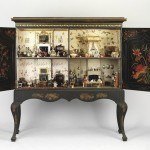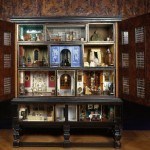Cabinet Dollhouses
A Cabinet Of Curiosities
The term cabinet was originally used to describe a room, rather than a piece of furniture. A “Cabinet of Curiosity” could contain collections of unusual items: fossils, scientific studies, oddities gathered from newly discovered lands. These rooms were often lavishly decorated, the treasures displayed in a setting designed for their maximum effect.
Cabinet On A Stand
Cabinets like the one above were the height of fashion in France from about 1640 to 1660. They were used to house collections of precious objects and natural rarities, such as unusual shells. They were also admired as luxury objects in their own right
John Evelyn was a seventeenth-century diarist and collector interested in many scientific and scholarly matters of his day. While on a visit to Paris in 1652, his wife Mary purchased a cabinet-on-stand from craftsman Pierre Golle, who had mastered the art of marquetry on fine furniture by inlaying veneers of ebony, rosewood, and fruit woods with ivory, gilt wood, pewter, and brass.
Mary Evelyn felt an attractive piece of furniture would draw attention to a collection of small specimens, which were lost in a chamber crammed with so many items of varied interests.
Dutch Cabinet Dollhouses
Dollhouses had become popular in the Netherlands, not as architectural miniatures, but as a way to show how people lived: details about the household, routines with servants, kitchen settings, boudoirs, etc. They were often wedding presents to the bride, mirroring her family home to soothe her homesickness.
Petronella de la Court Cabinet Dollhouse
It wasn’t long before the cabinet dollhouse became popular. In 1670, Petronella de la Court, wife of an Amsterdam beer merchant, commissioned a dollhouse that set the standard for all cabinet dollhouses to come.
Important craftsmen and artists were employed; it took nearly 20 years to build. The case was made of olive wood. It is divided into eleven parts so the owner could take it with her on travels to show-off to her friends. The dollhouse is lavishly equipped and filled with rich trinkets. It contains 1,600 various objects, from 28 dolls to Dutch paintings, ivory bas-reliefs, sculptures, finely made clocks. Even a globe with a brass stand and illustrated books with leather covers. Sometime around 1800, all the original silver was stolen. Some replacements have been purchased.
At present, it is supposed to be on display at the Centraal Museum in Utrecht, but in searching the site I get a “No such item” reply. Please send me a link if you find the Petronella de la Court cabinet dollhouse.
At present, it is supposed to be on display at the Centraal Museum in Utrecht, but in searching the site I get a “No such item” reply. Please send me a link if you find the Petronella de la Court cabinet dollhouse.
Another Petronella Dollhouse
(Image is shown at the top of the article; this text is from Illeana Ottini’s website)
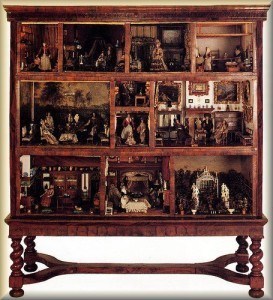
Petronella de la Court Cabinet Dollhouse, supposedly on exhibit at the Centraal Museum in Utrecht
In 1686, Petronella Oortman, married to the rich silk merchant Johannes Brandt, commissioned an elaborate cabinet house, consisting of nine rooms.
The house of Petronella Oortman, whose cost is estimated at around 20-30,000 florins (about EUR 10,000) contains a room with frescoes on the walls that are attributed to the great Flemish painter Willem van Rooyen. The entrance of that room has a ceiling decorated with an allegory attributed to Johannes Voorhout. The room also contains two benches carved from olive wood and stained glass and a high cabinet. On a coffee table is placed a silver pot high 47 mm made by Christiaan Warenberg, a well-known name to antique dealers and collectors of antique silverware. Porcelain in a plate rack had been expressly ordered in China and Japan.
In workrooms are charcoal tongs of iron and brass. In the laundry room are wicker baskets for linens with wooden handles and ingenious presses where damp laundry is dried and ironed.
A room where the new mother and her child, assisted by a nurse, would receive visitors had a coffee table with an elegant white lace tablecloth and a service in Dresden china and silver worth a fortune. In the kitchen we find glass jars with a lid made of skin, containing real herbs. The furniture in all the rooms is fully formed. There are dresses made of silk and wool, table linen and cotton bed and linen, pottery and pots and tools. Of special interest are books with fine leather bindings, stamped in gold and endpapers with parchment … in short, true works of art. The real prize is a meticulous reproduction of an oil painting by the Dutch artist Jacob Appel (1680-1731)
Sara Rothe Had Two of Them
On April 2, 1743, Sara Rothe was the high bidder on 3 dollhouses created by Cornelia van der Gon, a leading dollhouse builder of the time. The incentive seems to have been to scavenge these dollhouses for their contents to improve the two cabinet dollhouse Rothe already owned. One is based on her canal house in Amsterdam; the other, her summer home in what is now a Haarlem.
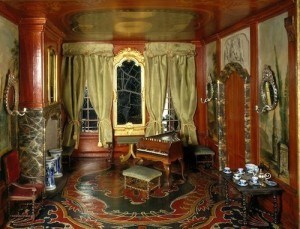
The Painted Room in Sara Rothe’s cabinet dollhouse at the Frans Hals Museum in Haarlem, the Netherlands. Found on “All About Dollhouses and Miniatures.”
Apparently, it worked out. One dollhouse purchased at auction was in poor condition but had an exceptional group of dolls in it. It is on exhibit at the Gemeente Museum in The Hague. The other cabinet dollhouse is displayed at the Frans Hals Museum in
Cabinet Dolls Houses In England
Cabinet dolls house were not as popular in England. The gentry preferred to impress their visitors with miniature architectural details and pricey furnishings, rather than depictions of domestic routine. There are notable exceptions.
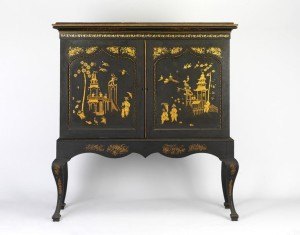
The Killer Cabinet at the Victoria & Albert Museum, London
The Killer Cabinet
This gorgeous cabinet dollhouse belonged to John Egerton Killer, of Manchester. He wanted to amuse the many ladies in his family by providing them with a baby house. In the late 1830s, he rdered a copy of a favorite cabinet in his office. Guess John Egerton Killer’s profession: he was a surgeon! The Killer Cabinet is part of the permanent collection at Victoria & Albert Museum, London. Two other famous cabinet dollhouse are also on exhibit: Mrs. Neave’s dolls’ house (1840) and Miss Miles’ House (1890). See all the dolls house on exhibit at the V&A.
Who’s Doing Cabinets Today?
Xandra Dekker has turned a display cabinet into a seven-level dollhouse. A description and photographs of the components can be seen on her blog – All About Dollhouses and Miniatures.
How About You?
Do you have an interest in having an attractive piece of furniture to display a miniature project? Do you have space? Think of all the out-of-style, glass-fronted knick-knack and curio cabinets that can be purchased inexpensively at used furniture stores. Something all beat up, with lots of filigree and gargoyles which might now be considered gauche. But with a little paint and wood putty can be turned into a fine cabinet dollhouse.
Think about it.
Susan Downing, with Patrick Owens
_____________________________________________________________________________________
I invite you to visit my Etsy Shop where I offer many accessories and pieces of furniture in 1:12 scale.





